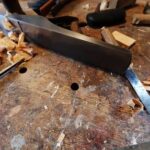Are you wondering how to clean old paint off woodwork? Over time, old paint can build up on woodwork, causing it to look dull and worn.
In this article, we will explore the importance of cleaning old paint off woodwork and provide you with a step-by-step guide on how to effectively remove it. Whether you’re looking to refresh the appearance of your home or restore an antique piece of furniture, understanding the process of removing old paint is essential for achieving a polished finish.
Assessing the condition of the woodwork is crucial before starting the cleaning process. By identifying the type of paint and level of damage, you can determine which method will work best for removing the old paint. Additionally, gathering the necessary supplies and ensuring proper ventilation are essential steps in preparing for this project.
In the following sections, we will compare various methods for removing old paint from woodwork, including chemical strippers, heat guns, and scraping techniques. We will also provide detailed instructions on how to use each method effectively and safely. By the end of this article, you will have a clear understanding of the importance of regular maintenance to prevent old paint buildup in the future. So let’s get started on revitalizing your woodwork.
Assessing the Condition of the Woodwork
When it comes to cleaning old paint off woodwork, it is crucial to assess the condition of the wood and the type of paint that has been used. This will help determine the best method for removing the old paint without causing damage to the wood itself.
The first step in this process is to identify whether the paint is latex-based, oil-based, or lead-based. This can usually be done by scraping a small section of the paint and conducting a simple test using denatured alcohol or a lead test kit.
In addition to identifying the type of paint, it’s important to assess the level of damage on the woodwork. Look for any signs of rot, decay, or previous repairs that may affect the removal process.
It’s also important to check for any moisture or mold that may be present underneath the layers of old paint. This will determine how aggressive you can be in removing the old paint and whether any additional repairs or treatments are necessary before proceeding with the cleaning process.
By thoroughly assessing the condition of the woodwork and identifying the type of paint used, you can ensure that you choose an appropriate method for removing old paint without causing further damage. Whether you opt for chemical strippers, heat guns, or scraping techniques, understanding these key factors will make your project more successful and prevent potential harm to both yourself and the woodwork.
Prep Work
When it comes to removing old paint from woodwork, proper prep work is essential to ensure the process goes smoothly and safely. Before you begin this task, it’s important to gather the necessary supplies and make sure you have proper ventilation in the work area. This will not only make the job easier but also protect your health during the paint removal process.
To prepare for removing old paint off woodwork, here are some supplies you may need:
- Protective gear such as gloves, goggles, and a mask
- Chemical paint stripper or heat gun (depending on the method you choose)
- Scraper or putty knife
- Sandpaper or sanding block
- Clean rags or paper towels
- Drop cloth or plastic sheeting to protect surrounding areas
Once you have gathered your supplies, it’s important to ensure proper ventilation in the area where you will be working. The fumes from chemical strippers and heat guns can be strong and potentially harmful if inhaled. If possible, open windows and use fans to increase air circulation. If working indoors, consider using a respirator mask with appropriate filters to protect yourself from inhaling any harmful fumes.
By taking the time to gather the necessary supplies and ensuring proper ventilation before starting your project, you can set yourself up for a successful and safe old paint removal process. These steps will help make the task easier and more efficient while protecting your health during the woodwork restoration process.
Choosing the Right Method
When it comes to removing old paint from woodwork, there are several methods to choose from. Each method has its own advantages and disadvantages, so it’s important to consider the type of paint and the condition of the woodwork before deciding on the best approach.
One popular method for removing old paint is using chemical strippers. These powerful solvents work by softening the paint, making it easier to scrape off. Chemical strippers are effective for removing multiple layers of paint and can be a good option for intricate or detailed woodwork. However, it’s important to use these products in a well-ventilated area and follow safety precautions to protect yourself from harmful fumes.
Another method for removing old paint is using heat guns. Heat guns work by softening the paint with heat, allowing it to be easily scraped off. This method is efficient and can be less messy than chemical strippers, but it requires careful attention to prevent scorching or damaging the woodwork. Additionally, heat guns can pose a fire hazard if not used properly, so it’s essential to follow safety guidelines when using this method.
Scraping techniques involve manually removing old paint using a variety of scraping tools such as putty knives or paint scrapers. This method is labor-intensive and may take longer than using chemical strippers or heat guns, but it allows for greater control over the process and minimizes the use of potentially hazardous chemicals or equipment. Scraping techniques may be suitable for delicate woodwork or areas where other methods may not be practical.
Overall, choosing the right method for removing old paint from woodwork depends on factors such as the type of paint, the condition of the woodwork, and personal preference. It’s important to carefully consider these factors before beginning the process to ensure the best results while minimizing potential harm to yourself and the woodwork.
Step-by-Step Guide
When it comes to removing old paint off woodwork, there are several methods that can be used depending on the type of paint and level of damage. In this section, we will provide detailed instructions for each method to ensure that you can effectively clean old paint off woodwork.
Chemical Strippers
Using a chemical stripper is an effective way to remove old paint from woodwork. Start by applying the stripper with a brush, ensuring that you cover the entire surface. Allow the stipper to sit for the recommended time according to the product instructions. Once the paint begins to bubble and lift, use a putty knife or scraper to gently remove the old paint. Be sure to wear gloves and eye protection when using chemical strippers.
Heat Guns
Another method for removing old paint is using a heat gun. This technique involves heating up the old paint with the heat gun until it softens and bubbles. Use a scraper or putty knife to gently remove the softened paint. It’s important to keep the heat gun moving at all times to prevent scorching or burning the wood.
Scraping Techniques
If you prefer a more traditional approach, scraping off old paint with a putty knife or scraper is also an option. Simply use the blade of the tool to carefully scrape away layers of old paint from the woodwork. This method may require more time and effort, but it can be effective, especially for small areas.
Remember that no matter which method you choose, always follow up with proper sanding and refinishing for a polished look after removing the old paint off your woodwork.
Safety Precautions
Using Chemical Strippers Safely
When it comes to using chemical strippers to remove old paint from woodwork, it is important to prioritize safety. Always work in a well-ventilated area to avoid inhaling fumes, and consider wearing a mask, gloves, and protective eyewear to minimize exposure to potentially harmful chemicals. Additionally, be sure to read and follow the manufacturer’s instructions for the specific chemical stripper you are using.
Safe Operation of Heat Guns
If you opt for using a heat gun to remove old paint from woodwork, it is crucial to operate the tool safely. Keep the heat gun moving at all times to prevent scorching or burning the wood, and avoid pointing it at one spot for too long.
Make sure there are no flammable materials nearby, and always use the heat gun in a well-ventilated area. Additionally, wear protective gear such as gloves and safety goggles to shield yourself from heat and potential debris.
Protecting the Woodwork During Scraping
When using scraping techniques to remove old paint from woodwork, take measures to protect the wood from damage during the process. Use a putty knife or paint scraper with a flat edge to gently lift off old paint without gouging or scratching the surface underneath. Work slowly and carefully, applying even pressure as needed. Consider placing a drop cloth or tarp beneath the woodwork to catch any loose paint chips and prevent them from scattering around your work area.
By prioritizing safety precautions during the process of removing old paint from woodwork, you can ensure that both yourself and the wood are protected from potential harm. Whether using chemical strippers, heat guns, scraping techniques or any other method of paint removal, following these safety guidelines will help make the entire process smoother and safer.
Cleaning Up
After successfully removing the old paint from your woodwork, it is crucial to focus on the clean-up process. Properly disposing of the paint residue and cleaning the woodwork will ensure that you achieve a polished and finished look. This section will provide you with important tips on how to dispose of paint residue and thoroughly clean the woodwork.
First and foremost, it is essential to properly dispose of any paint residue that may have accumulated during the removal process. Many local waste management facilities offer specific guidelines for disposing of paint and related materials. It is important to follow these guidelines to ensure that you are in compliance with local regulations. Additionally, consider using eco-friendly disposal methods if available, as this will minimize environmental impact.
Once the paint residue has been disposed of, it is time to focus on cleaning the woodwork. Use a mild detergent mixed with water to clean the surface thoroughly. Gently scrub the woodwork using a soft-bristled brush or sponge, being careful not to damage the surface. After cleaning, rinse the woodwork with clean water and allow it to dry completely before proceeding with any further refinishing or sealing.
In addition to cleaning the surface, it may also be necessary to clean any tools or equipment used during the old paint removal process. Paint brushes, scrapers, or any other tools should be cleaned according to their specific requirements, as outlined by their manufacturers. Taking care of your tools will prolong their lifespan and ensure optimal performance for future projects.
Remember that proper disposal of paint residue and thorough cleaning of the woodwork are essential steps in achieving a professional-looking finish after removing old paint. By following these guidelines, you can ensure that your woodwork looks its best and is ready for any finishing touches needed.
Finishing Touches
After successfully removing the old paint from the woodwork, the next important step is to sand and refinish the surface to achieve a polished and clean look. This final step in the process will not only enhance the appearance of the woodwork but also provide long-lasting protection for the surface.
To ensure that you achieve the best results when finishing the woodwork, follow these steps:
- Gather your supplies: Before beginning the sanding and refinishing process, gather all necessary supplies including sandpaper (medium and fine grit), wood stain or paint, paintbrushes or a rag, and a sealant or varnish.
- Start with sanding: Begin by using medium grit sandpaper to smooth out any rough areas or uneven surfaces on the woodwork. Once you have achieved a smooth finish, switch to fine grit sandpaper to further refine the surface.
- Apply wood stain or paint: Depending on your preference, apply a wood stain to enhance the natural grain of the wood, or use paint for a more opaque finish. Apply multiple coats as needed, allowing each coat to dry completely before applying the next.
- Seal and protect: Once the stain or paint has dried, apply a sealant or varnish to protect the woodwork from moisture, dirt, and wear. Follow the manufacturer’s instructions for proper application and drying times.
By following these steps for sanding and refinishing your woodwork, you can achieve a professional-looking result that enhances both the appearance and durability of your wood surfaces.
Remember that maintenance is key in preventing old paint buildup in the future – regularly assess your woodwork for any signs of peeling or chipping paint and address them promptly using these cleaning methods.
Conclusion
In conclusion, it is crucial to understand the significance of regularly maintaining woodwork by removing old paint buildup. By assessing the condition of the woodwork and choosing the right method for removing old paint, you can ensure that your woodwork remains in top condition for years to come. Whether using chemical strippers, heat guns, or scraping techniques, it is essential to prioritize safety precautions and proper cleanup to protect both yourself and the woodwork from harm.
Regular maintenance not only keeps your woodwork looking its best but also prevents potential damage caused by old paint buildup. By taking the time to clean old paint off woodwork, you can prolong its lifespan and maintain its beauty. Additionally, implementing finishing touches such as sanding and refinishing after removing old paint can provide a polished look that enhances the overall appearance of your woodwork.
In summary, learning how to clean old paint off woodwork is an essential part of maintaining your home. By incorporating these methods into your regular home maintenance routine, you can prevent old paint buildup in the future and keep your woodwork looking beautiful for years to come. Remember that investing time in proper maintenance now will save you from costly repairs or replacements down the line.
Frequently Asked Questions
What Is the Best Way to Remove Old Paint From Wood Trim?
The best way to remove old paint from wood trim is by using a combination of heat, scraping, and sanding. You can use a heat gun to soften the paint, making it easier to scrape off with a putty knife.
Once the majority of the old paint is removed, you can then sand the wood trim to ensure a smooth surface for repainting or refinishing.
How Do You Get Dried Paint Off of Woodwork?
To get dried paint off of woodwork, you can start by using a scraper or putty knife to gently lift and remove as much of the dried paint as possible. Then, using a fine-grade steel wool or sandpaper, carefully sand the remaining dried paint until it is fully removed without damaging the woodwork.
What Removes Paint From Wood Without Damaging Finish?
When looking to remove paint from wood without damaging the finish, consider using a gentle solvent like denatured alcohol or mineral spirits. Apply the solvent to a clean cloth and gently rub the affected area, being careful not to scrub too aggressively which could potentially damage the finish of the wood.
This method will help dissolve and remove the paint without affecting the underlying finish on the wood.

Hi everyone! I’m a woodworker and blogger, and this is my woodworking blog. In my blog, I share tips and tricks for woodworkers of all skill levels, as well as project ideas that you can try yourself.





